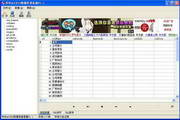Huahua Access database viewer is specially designed for friends who have not installed Access. It can open Access, SQL Server and other database tables. It is a free MDB file browser and editor.
Huahua Access database usage instructions:
1. You can view, edit, query and search, and modify Access MDB files without installing and running Microsoft's ACCESS database software.
2. The data table information in the opened data file can be displayed. Click the table name to read it on the right
3. It comes with a data display window. You can edit the content by pointing two fingers at a cell. After editing, click the Enter key to save the changes.
4. Click the plus sign to add a row of records. After adding, press the check button next to it to save it.
Introduction to Huahua Access database:
Microsoft Office Access is a relational database management system released by Microsoft. It combines the two features of Microsoft Jet Database Engine and graphical user interface, and is one of the system programs of Microsoft Office.
MS ACCESS stores data in its own format in an Access Jet-based database engine. It can also directly import or link data stored in other applications and databases.
ACCESS database function:
Database, as the name suggests: a warehouse of data. When the amount of data that the user needs to save is not very large, we can directly write the data to a file, such as a text file or binary file. But when the amount of data is large and we need to query and organize it in real time, directly manipulating text files or binary files will make the work extremely complicated. The database can manage data for the user. The user only needs to use relevant commands (such as SQL query language) to "talk" to the database and let the database perform the operations we want. For example: adding new data (insert), changing data (update), deleting data, retrieving data (query), etc. We no longer need to design how data is stored and retrieved ourselves, all this is left to the database. Using the database as the data carrier and combining it with specific development tools, practical database applications (such as various MIS) can be quickly developed. Access is a small database, but if it is your first time to use a database, you can start with Access. Access is a product in the Microsoft Office suite (you will see it when you complete the installation). In addition to developing small desktop applications, there are also many small personal sites on the Internet that use the Asp+Access model. The user interface style of Access is similar to that of other members of Office. It is relatively easy to use. Database editing is completely visual, and the powerful Office programming environment VBA is built-in. You can quickly develop a desktop database system without the need for third-party programming software.
What database objects does Access have?
Access database consists of seven types of objects, which are tables, queries, forms, reports, macros, pages and modules.
Table (Table) - Table is the basic object of the database and the basis for creating the other five objects. Tables are composed of records, and records are composed of fields. Tables are used to store database data, so they are also called data tables.
Query - Query can quickly find the required records according to the index, filter the records according to the requirements and connect the fields of several tables to form a new table.
Form (Form) - Form provides a convenient window for browsing, inputting and changing data. You can also create subforms to display the contents of associated tables. A form is also called a form.
Report - The function of the report is to classify and summarize the data in the database and then print it out for analysis.
Macro - Macro is equivalent to batch processing in DOS, used to automatically perform a series of operations. Access lists some commonly used operations for users to choose from, which is very convenient to use.
Module - The function of a module is similar to that of a macro, but the operations it defines are more detailed and complex than macros. Users can write programs according to their own needs. The module is programmed using Visual Basic.
Page - is a special kind of WEB page that is directly connected to the data in the database. The data is published to the Internet or Intranet through the data access page, and the browser can be used to maintain and operate the data.
Similar software
Release Notes
Software address
Green version
Check
Green version
Check
Green version
Check
Green version
Check




 360 Guardian
360 Guardian
 360 software manager
360 software manager
 driver wizard
driver wizard
 Baidu Skydisk
Baidu Skydisk
 360 browser
360 browser
 WPS Office
WPS Office
 QQ game hall
QQ game hall
 Lightning simulator
Lightning simulator
it works
it works
it works